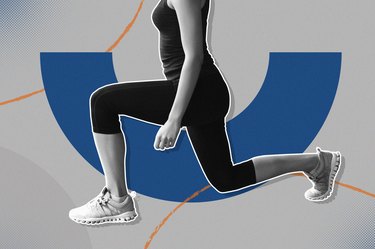
Second only to squats (and maybe deadlifts), lunges are one of the most functional exercises you can do. They work the same muscles you use to climb up stairs, step over the pile of laundry you're trying to ignore or walk your dog around the neighborhood.
But what happens if you do lunges every day? If doing them once in a while is good, then doing them daily should be even better, right? Not exactly. While there are some benefits, there are also some drawbacks to consider.
Video of the Day
Theresa Marko, board-certified clinical specialist in orthopedic physical therapy and owner of Marko Physical Therapy, and Nicholas Rizzo, biologist and fitness research director at RunRepeat, explain what happens when you do lunges every day (and if you should try it).
Your Muscular Strength and Endurance Will Increase
The primary muscles targeted during lunges are the quads and hamstrings in the lead leg and the glutes, hamstrings and calf in the rear leg, Rizzo says. You also work a ton of smaller stabilizer and synergistic muscles.
And if you hold weights — like a dumbbell, barbell, medicine ball or kettlebell — you'll challenge your core and even work some upper-body muscles.
"Based on what kind of lunge you are doing, there are different levels of stability and balance required," Rizzo says. "The more balance required, the more your core and back are recruited in these movements, making them effective for improving overall core strength."
Even if you don't do weighted lunges every day (which experts agree you shouldn't be doing), doing body-weight lunges can improve your muscular and cardiovascular endurance. Just make sure to switch up the lunge variations you're performing, mixing in more stretching types between any heavy-lifting days.
Your Hip Mobility May Improve
You might consider lunges primarily a strengthening exercise, but they also require a great deal of joint mobility, particularly in the ankles, knees and hips, Marko says. For example, if you have limited range of motion in your ankles, you may struggle to keep your front foot planted during lunges, which can lead to instability.
Your muscles need to be flexible enough to perform lunges, too. For example, if your quads are too tight, you may not be able to extend your rear leg far enough, which means you won't be able to create a 90-degree angle with your front leg.
Don't expect daily lunges to be an automatic antidote to mobility problems. In fact, doing lunges every day with limited mobility and flexibility can reinforce poor movement patterns and increase your risk of injury, Marko says. It's best to work on your mobility and flexibility first and add lunges to your routine when you can perform them correctly.
If you struggle with the mobility aspect of lunges, try out the world's greatest stretch for your ankles and hips:
- Start in a high plank position with your hands below your shoulders.
- Step your right foot up and place it just outside of your right hand. Keep your foot flat and your hips square.
- Lower your right elbow to touch the floor inside of your right foot.
- Lift your right hand high into the sky and twist your torso to follow.
- Bring your right hand back to the ground and return your right foot so you're back in plank position.
- Repeat on the left side.
Tip
Do 2 sets of 10 reps of this stretch 2 to 3 times per week, before or after your workouts. Pay close attention to your form to avoid reinforcing any incorrect movement patterns.
Your Risk of Injury Could Rise
"A stepping lunge is quite complex, as you need to step forward, plant your foot in a good spot that is distant enough for your leg length, then slowly lower down with control, and raise back up with control," Marko says. In other words, a lot could go wrong.
For example, lunges require a great deal of balance and stability. Without that, you might wobble and fall, potentially hurting an ankle or knee. Improper lunge technique also puts excess force on your shins, ankles and knees, which can lead to pain or, in worst-case scenarios, strained muscles or torn ligaments.
Plus, due to the unstable nature of the exercise, the eccentric portion (lowering phase) becomes even harder. Think about lowering in a squat versus a lunge: There's much more stability in a squat because both feet are planted near each other. During lunges, it becomes even harder to control your body against gravity, Marko says.
You May Experience Overtraining Symptoms
It is possible to do too many lunges too often, Marko says. And your body will tell you when you have.
"One might start to get a really tight muscle that leads to trigger-point tightness and restrictions, which would then cause restrictions in the joints," Marko says. "The IT band might also start to get really tight because it assists the hip abductors in stabilization and also helps the knee flex and extend with each up and down of the lunge."
When your IT band gets tight, it could pull at your kneecap, potentially leading to pain around your knee.
"You do not want to work the same muscles over and over without giving them recovery time," Marko says. "This will lead to tendonitis, muscle strains due to tightness/trigger points and possible joint issues."
"Lunges can be a demanding movement and certainly can be done too much," Rizzo says. "The obvious signs of over-exercising, like muscles being too sore, being tired and worn down and being overall weaker all apply to lunges."
More specifically, if you're overdoing the lunges, you'll notice they become increasingly harder to perform. "Your form will be significantly worse and less consistent from repetition to repetition," Rizzo says.
How to Do Lunges Every Day Safely
Some fitness professionals would advise against doing lunges every day, while others might say it's OK as long as you're in tune with your body and aware of the potential risks — meaning, you know when to lay off.
If someone was adamant about doing lunges every day, Marko would recommend experimenting with various lunge variations, like reverse lunges or lunges on a BOSU ball, for example.
If you do decide to do lunges every day, make sure you are prioritizing rest and recovery, which is when your muscles repair and grow. Recovery isn't just about days off, it also means eating a balance diet, getting plenty of sleep, stretching and drinking enough water, according to the National Academy of Sports Medicine.
When you work out, vary the weight and rep scheme for your lunges and consider incorporating similar movements for variety, like split squats, single-leg deadlifts and single-leg glute bridges. And at least one day a week, do lunges with just your body weight and focus on mobility.
Here's an example routine if you're set on doing lunges (or some variation) every day:
- Monday: barbell walking lunges
- Tuesday: body-weight Bulgarian split squats
- Wednesday: dumbbell reverse lunges
- Thursday: lunge stretches
- Friday: body-weight lunges
- Saturday: side lunges
How to Do Lunges Properly
- Start standing tall with your feet about shoulder-width apart. You can let your arms hang by your sides, place your hands on your hips, or clasp your hands in front of your chest.
- Step one leg forward and plant your foot firmly. Make sure your other foot is far enough behind you that your front leg will make a 90-degree angle when you lower.
- Once your foot is planted, slowly lower your back knee toward the ground until your front leg makes a 90-degree angle. Be careful not to bang your knee. Stop just a few centimeters above the ground if it helps you avoid that.
- Push off of the ground with your front foot and bring your legs back together.
- Repeat, only step the opposite foot forward this time. Continue alternating until you reach your desired rep count.
How Many Lunges Should You Do Daily?
Whether or not you can or should do lunges every day depends on your fitness level and your individual risk of injury. If you use weights during lunges, the load will affect your rep count, too. Try starting with 3 sets of 10 lunges on each leg (20 total) with no weight. If that feels good, add a little bit of weight and try for the same rep count next time.
You probably shouldn't do more than 4 or 5 sets of lunges in a day in order to reduce your risk of overtraining the muscles in your legs and to prevent severe soreness.
You'll also want to limit the number of lunges you do each day so you can keep your performance up to par — there's really no point in doing lunges each day if you can't perform them properly or safely.





